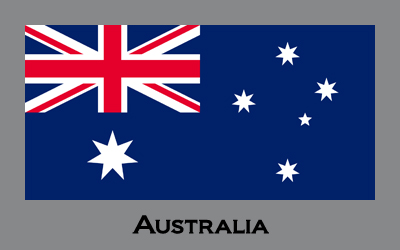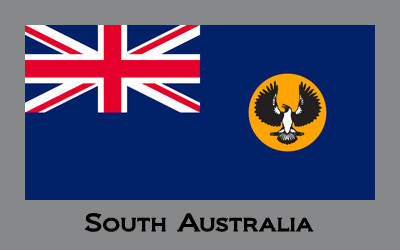|
Australia is nearly three million square miles. That is as small as it can be and still be an island continent. It is the smallest of all seven continents. Australia is between the Pacific and Indian oceans in the Southern Hemisphere. Its capital is Canberra.
Australia has six states: New South Wales (NSW), Queensland (QLD), South Australia (SA), Tasmania (TAS), Victoria (VIC) and Western Australia (WA) and two territories, the Australian Capital Territory (ACT) and the Northern Territory (NT). The two territories function as states, except that the Commonwealth Parliament has the power to modify or repeal any legislation passed by the territory parliaments.
Indigenous Australians inhabited the continent for about 65,000 years prior to the first arrival of Dutch explorers in the early 17th century, who named the country New Holland. Australia is the oldest, flattest, and driest inhabited continent, with the least fertile soils. It has a landmass of 7,617,930 square kilometres (2,941,300 sq miles).
A mega-diverse country, Australia has a wide variety of landscapes, with deserts in the centre, tropical rainforests in the northeast, and mountain ranges in the southeast.
Australia generates income from a wide variety of sources, including mining-related exports, telecommunications, banking, manufacturing, and international education.
Australia is a highly developed country, with the world's 14th-largest economy. It has a high-income economy, with the world's tenth-highest per capita income. It is a regional power and has the world's 13th-highest military expenditure.
The country ranks highly in quality of life, health, education, economic freedom, civil liberties, and political rights. Australia is a member of the United Nations, G20, Commonwealth of Nations, ANZUS, Organisation for Economic Co-operation and Development (OECD), World Trade Organization, Asia-Pacific Economic Cooperation, Pacific Islands Forum, and the ASEAN Plus Six mechanism.
Australia is experiencing a shift towards an older population, with more retirees and fewer people of working age. In 2018 the average age was nearly 40 years old. Today the population consists of more than 270 ethnic groups. Immigrants account for approximately 30 percent of the overall population, the highest proportion in any country with a population over ten million.
Australia has no official language, but English is the main language. Australian English is a major variety of the language with a distinctive accent and lexicon, and differs slightly from other varieties of English in grammar and spelling. There are some languages of immigrant groups, most notably Chinese, Italian, and Greek.
There are hundreds of Aboriginal languages, though many have become extinct since 1950, and most of the surviving languages have few speakers. Mabuiag, spoken in the western Torres Strait Islands, and the Western Desert language have about 8,000 and 4,000 speakers, respectively. Approximately 50,000 Aboriginal people may still have some knowledge of an Australian language.
Australia has no state religion. The Australian Constitution prohibits the federal government from making any law to establish any religion, impose any religious observance, or prohibit the free exercise of any religion.
Australia has world-class beaches, more than 10,000. The beaches look different in the tropical northern part, opposed to the windswept southern part. There is untamed wilderness in Kimberley in Western Australia and Arnhem Land in the Northern Territory. The white sand beaches and palm trees of tropical North Queensland, look different from the coastline that hugs Victoria's Great Ocean Road or Sydney's legendary city swimming spots.
Australia is the only continent without an active volcano. Its isolation from other continents explains much of the singularity of its plant and animal life. Its unique flora and fauna include hundreds of types of giant eucalyptus trees and the Golden wattle (Acacia pycnantha) that is native to southeastern Australia and was named the national flower of Australia in 1988. Australia has the only egg-laying mammals on earth, the platypus and echidna. Other animals include dingoes, kangaroos, the wallaby, the wombat, possums and gliders, koalas, the spiny anteater, kookaburras, and various birds. Australia has 27 species of possums and gliders. (More about possums later.)
The Great Barrier Reef, off the east coast of Queensland, is the greatest mass of coral in the world and a huge tourist attraction.
The distribution of climates, topography, and soils that has produced the zones and ecological variation of Australian vegetation has also been reflected in the distribution of animal life. Australia probably has between 200,000 and 300,000 species, about 100,000 of which have been described. There are some 250 species of native mammals, 550 species of land and aquatic birds, 680 species of reptiles, 190 species of frogs, and more than 2,000 species of marine and freshwater fish. The remainder species are invertebrates, including insects.
Australia has over 100,000 Aboriginal rock art sites, and traditional designs, patterns, and stories infusing contemporary Indigenous Australian art, "the last great art movement of the 20th century" according to critic Robert Hughes. Its exponents include Emily Kame Kngwarreye. Early colonial artists showed a fascination with the unfamiliar land. The impressionistic works of Arthur Streeton, Tom Roberts, and other members of the 19th century Heidelberg School, the first "distinctively Australian" movement in Western art, gave expression to nationalist sentiments in the lead-up to Federation.
While the school remained influential into the 1900s, modernists such as Margaret Preston, and, later, Sidney Nolan and Arthur Boyd, explored new artistic trends. The landscape remained a central subject matter for Fred Williams, Brett Whiteley, and other post-war artists whose works, eclectic in style yet uniquely Australian, moved between the figurative and the abstract.
The national and state galleries maintain collections of local and international art. Australia has one of the world's highest attendances of art galleries and museums per head of population.
Australian literature grew slowly in the decades following European settlement though Indigenous oral traditions, many of which have since been recorded in writing, are much older. In the 1870s, Adam Lindsay Gordon posthumously became the first Australian poet to attain a wide readership. Following in his footsteps, Henry Lawson and Banjo Paterson captured the experience of the bush using a distinctive Australian vocabulary. Their works are still popular.
Paterson's bush poem "Waltzing Matilda" (1895) is regarded as Australia's unofficial national anthem. Miles Franklin is the namesake of Australia's most prestigious literary prize, awarded annually to the best novel about Australian life. Its first recipient, Patrick White, won the Nobel Prize in Literature in 1973.
Australian Booker Prize winners include Peter Carey, Thomas Keneally, and Richard Flanagan. Author David Malouf, playwright David Williamson, and poet Les Murray are also renowned.
Many of Australia's performing arts companies receive funding through the federal government's Australia Council. There is a symphony orchestra in each state, and a national opera company, Opera Australia, well known for its famous soprano Joan Sutherland. At the beginning of the 20th century, Nellie Melba was one of the world's leading opera singers. Ballet and dance are represented by The Australian Ballet and various state companies. Each state has a publicly funded theatre company.
Australia is known for its cafe and coffee culture in urban centres, which has influenced coffee culture abroad, including New York City. Australia claims invention of the flat white coffee, purported to have originated in a Sydney cafe. A flat white consist of espresso with microfoam - steamed milk, comparable to a latte, but smaller in volume and with less microfoam. References to the beverage dates to the mid-1980s in Australia. However, the origins are contentious, New Zealand also claims the invention.
Cricket and football are the predominating sports during summer and winter. Australia has professional leagues for four football codes. Australia water sports include swimming and surfing. The surf lifesaving movement originated in Australia, and the volunteer lifesaver is one of the country's icons. Other popular sports include horse racing, basketball, and motor racing. The annual Melbourne Cup horse race and the Sydney to Hobart yacht race attract intense interest. Australia is one of five nations to have participated in every Summer Olympics of the modern era, and has hosted the Olympic Games twice: 1956 in Melbourne and 2000 in Sydney.
Immigration:
Responding to the influx of Chinese immigrants, the Immigration Restriction Act of 1901 ("White Australia" policy) aimed at excluding all people who were not of British or European descent from entering the country. This law was designed to prevent the diluting of Australia's Anglo-Celtic heritage - that is, to support the notion of a homogeneous country consisting purely of a "white" population.
Immigrants who wished to settle in Australia were required to pass a dictation test administered in English or a European language. This made it difficult for Asian migrants. By the late 1940s people of Asian descent made up only approximately 0.21 percent of Australia's population. Although the policy was unproductive and discriminatory, it was made attractive by blending imperial and nationalistic sentiments that proclaimed "population capacities" of 100 to 500 million in Australia's "vast empty spaces."
The massive influx of migrants in the postwar years marked a major cultural shift from a mono-cultural British-oriented society to one of the world's most multicultural societies. From 1945 to 1960 Australia's population almost doubled, from seven million to 13 million. By 1961, eight percent of the population was not of British origin, with the largest migrant groups being Italians followed by Germans, Greeks, and Poles.
In the mid-1950s, as the Australian government began to relax its White Australia policy, one of the first changes was to allow non-European migrants to apply for citizenship. This was followed by the abolition of the dictation test under the Migration Act of 1958, which put an end to the exclusion of non-European migrants.
The most significant change was Prime Minister Harold Holt's introduction of the Migration Act 1966. This allowed non-Europeans with professional and academic qualifications to apply for entry. This ended the White Australia policy (which was officially abandoned in 1973) with migrants being selected according to their skills and ability to contribute to Australian society, not on the basis of ethnicity. This act aimed at developing trade, tourism, and closer ties between Australia and other countries, particularly in Asia.
The 1970s marked a significant turning point in official immigration policies and in prior assimilation policies whereby new arrivals were expected to adopt Australian customs and culture. In 1973 the new Labor government, led by Prime Minister Gough Whitlam, implemented the Universal Migration Policy, heralding the beginning of a culturally diverse society.
This radical change in policy allowed a person from any country to apply to migrate to Australia, without being discriminated against on the basis of ethnicity, gender, or religion. The policy encouraged skilled and professional workers to apply for immigration to increase Australia's productive capacity and to directly benefit the economy. Mass migration programs were renounced, resulting in a dramatic decline in the number of British and European immigrants from 1975.
A new wave of migration began with the arrival of the first Asian refugees as part of the assistance programs signed with the United Nations to provide resettlement in Australia for people fleeing hardship and government persecution in other countries. As the Vietnam War wound down, most of the refugees came from Southeast Asia, fleeing persecution from communist regimes.
In 1975 the first refugees arrived from Vietnam by boat, landing on the shores of Darwin, Northern Territory. By 1985 more than 75,000 refugees from Southeast Asia had come to Australia. These immigrants worked mostly in low-skilled jobs. The number of migrants from Asian regions continued to increase during the 1990s, peaking in 1990-1991 with 60,900 settlers. By 1998, 33 percent of Australian migrants were Asian-born.
|





